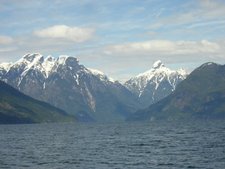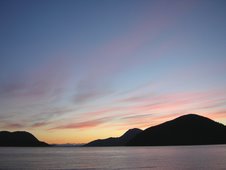
Record catches, close calls, boat building and the dwindling fish runs were some of the subjects covered by Egmont commercial fishermen Leonard Silvey, Billy Griffith and John West at the Egmont Heritage Centre on Saturday, November 15. The men have been fishing the coastal waters for over 70 years and they brought their stories and pictures to share with a very appreciative audience.
Leonard Silvey, a fourth generation fisherman and a descendant of Portuguese Joe Silvey, was born in Egmont in 1933 and has lived in Egmont all his life. He began fishing on his grandfather Henry’s boat, the New Castle 4, as a deck hand at the age of 13. In 1950 he acquired his first boat which was powered by a 5 horsepower Easthope engine. He had a couple of more boats before buying the Silver Side around 1954 which he still fishes with to this day.
Billy Griffith, another life-long fisherman, was born in New Westminster in 1934 and has also lived in Egmont all his life. He started fishing for cod in 1953 with a boat with a 6 horsepower Easthope engine. Since the mid-1950’s he has fished with the Tzoonie River which has a 200 horsepower engine. Griffith remembers 20 cents per Imperial gallon fuel prices. He says with the current terrible fuel prices he can still come out okay compared to the modern “steel boxes” that are the new boats of today.
John West was born in Vancouver in 1913 and came home to Westmere on Nelson Island as a newborn baby. He grew up there and then worked in Vancouver where he learned woodworking. He returned to Nelson Island in 1933 and in 1941 purchased property in Egmont. West has built a number of boats from a 10 foot (3 meters) dugout canoe to his 43 foot (13.11 meters) troller the Mary Ann W named after his mother. He fished the coastal waters from Prince Rupert to the Columbia River for salmon and cod until 1973 when he retired.
All of the men had stories of record catches with their seine nets. As Griffith said, “You have to be smarter than the fish to troll, but with seining, you only have to be smarter than the net.”
Griffith told the story of a Frazer River fishery where many other boats set their nets before the opening. His boat came in at 7 a.m. and set in the one remaining open patch of water. With just his wife and daughter as crew, they hauled in over 3000 sockeye or around 20,000 pounds (9,071.85 kg.) of fish. They were paid $1.50 per pound that season.
A good sockeye run was the best catch related by Leonard Silvey. He remembers a catch in 1958 in the Straits where he caught around 2500 sockeye that loaded his boat to the stern.
John West remembered a record catch of spring salmon in the ‘60’s around Cape Flattery. Coho were reported at 10 to 50 fathoms. After about 2 hours out in the Mary Ann W they found them. He said they caught around 200 fish everyday with a total haul of 9000 pounds (4,082.33 kg.) for that season.
These large catches didn’t necessarily mean anyone was getting rich. West brought his fisherman’s log book which showed salmon prices in the years of 1940 and 1941. He received 14 cents per pound for red salmon and 7 cents a pound for whites.
The men have sold to any number of buyers over the years from the local Japanese fish buyers in old Egmont to the fishermen’s co-op. Some of the canneries such as the Queen Charlotte Cannery used to send scows to the area to buy the fish. There are fewer buyers now as the larger corporations take over the smaller companies.
While many of the commercial fishermen have worked for the large corporations, all of these men have remained independent fishermen through the years. They started small, built their own boats or purchased used ones for a good price. Griffith said that sadly many of the fishermen who are under contract to the large companies have to take the price they are offered because they owe them for their boats and gear. Unfortunately, many of these men have been unable to make their payments and have lost their boats.
The men also had stories of some close calls. West recalled a time about 100 miles out of Cape Flattery while fishing for tuna. After a poor drift and few tuna, it began blowing hard from the southwest. “Water was blowing over the stovepipe, the bilge was plugged up and the boat sprung a leak,” said West. “We had to go in. It was really rough, but we made it to Victoria. There the boat was hauled out and repaired.”
Griffith said he had hit everything from logs to rocks to sand bars. “It’s not the accident itself,” said Griffith, “but how you behave after that accident that’s important.”
The discussion turned to the present day situation for fishermen. Griffith said the south coast was in bad shape while the north coast was better. He said they got an increase this season in the sockeye quota.
When asked where are all the fish? The men agreed that everyone was to blame for the lack of fish from over fishing by the commercial fishery to sports fishermen to lack of good habitat from logging practices. But they sited the herring fishery as the main problem. “You can’t take all the food fish,” said West. He explained that without the food fish there is nothing to sustain the larger fish. All of them expressed concern that fish stocks were dwindling and the orcas were disappearing. They felt that a moratorium on the herring fishery was in order. This does not include the herring roe on kelp fishery which doesn’t kill the herring.
While West has retired, you can still see the Tzoonie River and the Silver Sides plying the waters, searching for that good day’s catch.






